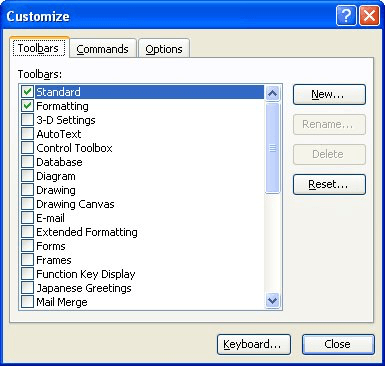Written by Allen Wyatt (last updated September 25, 2021)
This tip applies to Word 97, 2000, 2002, and 2003
Word is a very flexible program. You can configure it to work just about any way you can imagine. For instance, you can create a macro, and then add it to a toolbar. How you do this depends on which version of Word you are using.
If you are using a version of Word prior to Word 2007, then follow these steps:

Figure 1. The Toolbars tab of the Customize dialog box.
Word 2007 is different; it doesn't technically have toolbars like older versions of Word had. You can't make additions or changes to the ribbon, but you can add macros to the Quick Access toolbar. Follow these steps:
Note:
WordTips is your source for cost-effective Microsoft Word training. (Microsoft Word is the most popular word processing software in the world.) This tip (1879) applies to Microsoft Word 97, 2000, 2002, and 2003.

Create Custom Apps with VBA! Discover how to extend the capabilities of Office 2013 (Word, Excel, PowerPoint, Outlook, and Access) with VBA programming, using it for writing macros, automating Office applications, and creating custom applications. Check out Mastering VBA for Office 2013 today!
One of the properties that Word maintains for a document is a title. If you want this title displayed on the title bar ...
Discover MoreYou'd think that Word would be consistent, right? Wrong! Here's one example where Word is anything but consistent when it ...
Discover MoreOne of the math functions you can use in your macros is the Int function. It provides a way for you to derive an integer ...
Discover MoreFREE SERVICE: Get tips like this every week in WordTips, a free productivity newsletter. Enter your address and click "Subscribe."
There are currently no comments for this tip. (Be the first to leave your comment—just use the simple form above!)
Got a version of Word that uses the menu interface (Word 97, Word 2000, Word 2002, or Word 2003)? This site is for you! If you use a later version of Word, visit our WordTips site focusing on the ribbon interface.
Visit the WordTips channel on YouTube
FREE SERVICE: Get tips like this every week in WordTips, a free productivity newsletter. Enter your address and click "Subscribe."
Copyright © 2024 Sharon Parq Associates, Inc.
Comments